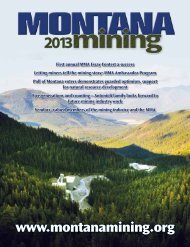2009 Montana Mining - Montana Mining Association
2009 Montana Mining - Montana Mining Association
2009 Montana Mining - Montana Mining Association
Create successful ePaper yourself
Turn your PDF publications into a flip-book with our unique Google optimized e-Paper software.
Hydrologic control for<br />
current mine and lease by<br />
modifying surface coal mines<br />
in southeastern <strong>Montana</strong><br />
As mining operations change and continue<br />
to expand, the need for hydrologic<br />
control becomes an integral part of<br />
mining operations. The purpose of hydrologic<br />
control is the safe and uninterrupted operation<br />
of mining activities and the ability to<br />
contain sediment transported in storm water<br />
runoff. Surface water control includes flood<br />
control upstream of mining activities, and<br />
sediment control downstream of mining<br />
activities.<br />
HYDROLOGIC METHODS<br />
The design of hydrologic structures is<br />
dependant on the level of protection that<br />
management desires for the planned mining<br />
areas. Flood waters entering the mining area<br />
cause several potential concerns to the mine<br />
operation including personnel safety, equipment<br />
damage, the inability to mine while<br />
Reclaimed postmining channel, southeastern <strong>Montana</strong>.<br />
20 <strong>Montana</strong> <strong>Mining</strong> <strong>2009</strong><br />
water is being pumped out, and unstable<br />
highwalls where the flow of water has<br />
entered the pit. Typically, flood control structures<br />
should be designed to provide protection<br />
for at least a 100-year, 24-hour precipitation<br />
event. This is the amount of precipitation<br />
occurring over a 24-hour period that statistically<br />
may be exceeded once every 100<br />
years, or has a one in 100 chance that it will<br />
be exceeded during any given year.<br />
The MDEQ requires that sediment control<br />
structures have the capacity to contain runoff<br />
from the 10-year, 24-hour storm as well as<br />
the three year sediment volume, which is<br />
0.02 acre-feet/acre for the disturbed, contributing<br />
areas. The sediment control structure<br />
must also be capable of passing the 25year,<br />
24-hour flood through the spillway with<br />
minimal erosion. If a sediment control structure<br />
is greater than 20 acre-feet, then the<br />
spillway is required to pass the 100-year, 24hour<br />
peak discharge.<br />
Hydrologic Analysis<br />
The SEDCAD model uses a form of the<br />
Natural Resources Conservation Service (formerly<br />
SCS) Triangular Hydrograph Method,<br />
and is a parametric method of estimating<br />
flood peaks and runoff volumes from sitespecific<br />
data. The program uses the watershed<br />
area, time of concentration, SCS Curve<br />
Number and a unit hydrograph response<br />
shape to estimate the corresponding hydrograph.<br />
Watershed routing is accomplished<br />
utilizing the Muskingum method.<br />
Sediment Analysis<br />
The SEDCAD model calculates the<br />
expected sediment transport within the<br />
watershed utilizing a modified form of the<br />
Revised Uniform Soil Loss Equation (RUSLE).<br />
The model develops a sedimentgraph utilizing<br />
eroded soil particle size distribution, soil<br />
erodibility factor (K), representative slope<br />
length, representative slope, type of soil<br />
cover and control practices.<br />
HYDROLOGIC<br />
CONTROL METHODS<br />
Containment options provide flood control<br />
by establishing reservoirs upstream from<br />
the mining area. Sediment control is provided<br />
by establishing the reservoir downstream<br />
of the mining area. The size of the reservoir<br />
is based on a hydrologic analysis. Reservoirs<br />
fall into two size classifications: Mine Safety<br />
and Health Administration (MSHA) or Non-<br />
MSHA. MSHA-regulated reservoirs meet at<br />
least one of the following criteria:<br />
Greater than 20 acre-feet (ac-ft) of capacity<br />
and impound water to an elevation of five



